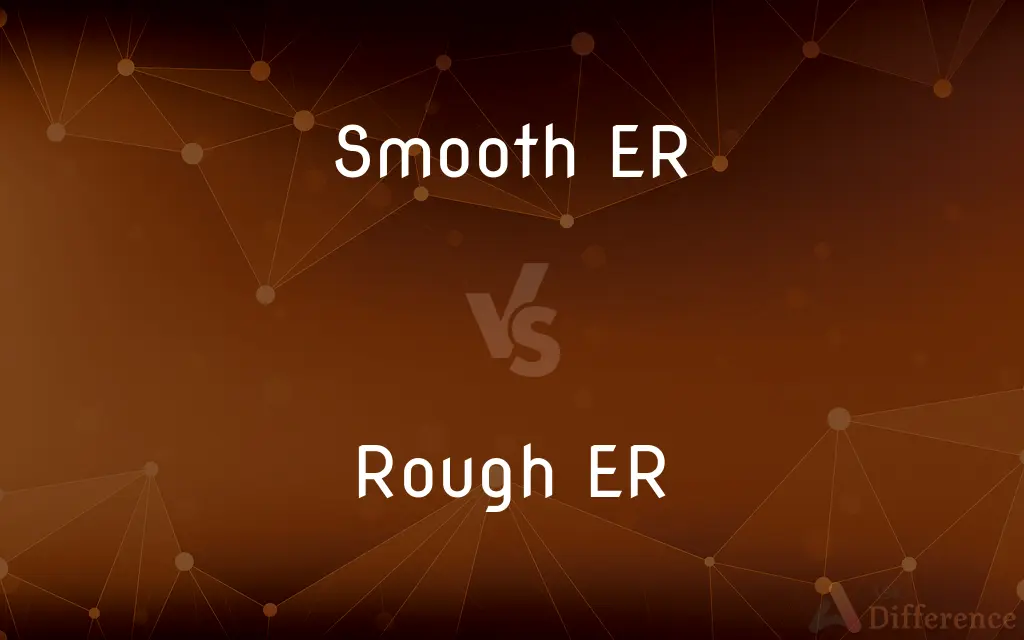Smooth ER vs. Rough ER — What's the Difference?
Edited by Tayyaba Rehman — By Fiza Rafique — Published on December 25, 2023
Smooth ER lacks ribosomes, while Rough ER has ribosomes attached to its surface.

Difference Between Smooth ER and Rough ER
Table of Contents
ADVERTISEMENT
Key Differences
Smooth ER plays a vital role in lipid synthesis and metabolism, detoxification, and calcium ion storage. It is called "smooth" because of its even appearance, devoid of any surface bumps. In contrast, Rough ER is actively engaged in protein synthesis and quality control, thanks to the ribosomes studding its surface, which give it a "rough" appearance.
Smooth ER is particularly abundant in cells that are specialized in lipid metabolism, such as liver cells. It facilitates the production of lipids, phospholipids, and steroids. Rough ER, on the other hand, is prominent in cells that are involved in producing large amounts of protein, like pancreatic cells. The ribosomes attached to the Rough ER synthesize these proteins.
Smooth ER helps in detoxifying many organic chemicals, converting them into safer, water-soluble forms. This detoxification role is crucial in liver cells where harmful substances are broken down. Rough ER, meanwhile, plays a pivotal role in the synthesis of lysosomal enzymes and integral membrane proteins. As proteins are made on the ribosomes of the Rough ER, they are threaded into the internal space of this organelle.
The calcium ion storage capability of the Smooth ER is instrumental for muscle cell function, facilitating muscle contraction. On the contrary, Rough ER ensures the proper folding and processing of proteins, even possessing a quality control mechanism where incorrectly made proteins are sent back to the cytosol to be degraded.
Comparison Chart
Surface Appearance
Smooth without ribosomes
Rough due to ribosomes
ADVERTISEMENT
Primary Function
Lipid synthesis, detoxification, calcium storage
Protein synthesis
Presence in Cell Types
Abundant in lipid metabolizing cells
Prominent in protein-producing cells
Role in Detoxification
Converts harmful chemicals into safer forms
Does not play a significant detox role
Associated Molecules
Enzymes for lipid synthesis
Ribosomes for protein synthesis
Compare with Definitions
Smooth ER
Smooth ER is an organelle involved in lipid synthesis.
The liver cell contains abundant Smooth ER to assist in lipid metabolism.
Rough ER
Rough ER synthesizes lysosomal enzymes and membrane proteins.
The enzymes destined for lysosomes are produced in the Rough ER.
Smooth ER
Smooth ER plays a role in calcium ion storage.
Muscle cells utilize the Smooth ER for storing calcium ions required for contraction.
Rough ER
Rough ER is an organelle studded with ribosomes.
The ribosomes on the Rough ER assist in protein synthesis, giving it a bumpy appearance.
Smooth ER
Smooth ER helps in the detoxification of harmful chemicals.
Smooth ER in liver cells transforms toxins into less harmful substances.
Rough ER
Rough ER ensures proteins are properly folded.
Malformed proteins in the Rough ER are directed to the cytosol for degradation.
Smooth ER
Smooth ER is devoid of ribosomes, giving it a smooth appearance.
Under a microscope, the Smooth ER appears even due to the absence of ribosomes.
Rough ER
Rough ER plays a crucial role in protein synthesis.
Cells that produce antibodies have abundant Rough ER to facilitate protein creation.
Smooth ER
Smooth ER is involved in the metabolism of carbohydrates.
In certain cells, Smooth ER aids in the breakdown and synthesis of glycogen.
Rough ER
Rough ER provides a quality control mechanism for protein production.
Proteins that fail the quality check in the Rough ER are prevented from reaching their destination.
Common Curiosities
What role does Rough ER play in the cell?
Rough ER is essential for protein synthesis and ensuring proper protein folding.
What gives the Smooth ER its name?
Smooth ER lacks ribosomes, giving it a smooth appearance.
Why is the Rough ER called "rough"?
Rough ER has ribosomes attached to its surface, giving it a bumpy or "rough" appearance.
In which cell type is Smooth ER particularly abundant?
Smooth ER is abundant in cells specialized in lipid metabolism, like liver cells.
What is the primary function of Smooth ER?
Smooth ER is involved in lipid synthesis, detoxification, and calcium ion storage.
How does Smooth ER contribute to detoxification?
Smooth ER helps convert harmful chemicals into safer, water-soluble forms.
How does Rough ER ensure protein quality?
Rough ER has a quality control mechanism, redirecting improperly made proteins for degradation.
Which ER type is involved in the synthesis of membrane proteins?
Rough ER synthesizes integral membrane proteins.
Are ribosomes present on Smooth ER?
No, Smooth ER is devoid of ribosomes.
Which ER is prominent in protein-producing cells?
Rough ER is prominent in cells producing large amounts of protein.
What is the relationship between ribosomes and Rough ER?
Ribosomes are attached to Rough ER and are responsible for its protein synthesis function.
Is Smooth ER involved in carbohydrate metabolism?
Yes, Smooth ER plays a role in the metabolism of certain carbohydrates.
Are there cells that contain both Smooth ER and Rough ER?
Yes, many cells contain both types of ER, each performing its specialized functions.
What role does Rough ER play in lysosomal enzyme production?
Rough ER synthesizes lysosomal enzymes destined for the lysosomes.
How does Smooth ER aid muscle cells?
Smooth ER stores calcium ions in muscle cells, facilitating muscle contraction.
Share Your Discovery

Previous Comparison
Resign vs. Re Sign
Next Comparison
Bronchi vs. BronchiolesAuthor Spotlight
Written by
Fiza RafiqueFiza Rafique is a skilled content writer at AskDifference.com, where she meticulously refines and enhances written pieces. Drawing from her vast editorial expertise, Fiza ensures clarity, accuracy, and precision in every article. Passionate about language, she continually seeks to elevate the quality of content for readers worldwide.
Edited by
Tayyaba RehmanTayyaba Rehman is a distinguished writer, currently serving as a primary contributor to askdifference.com. As a researcher in semantics and etymology, Tayyaba's passion for the complexity of languages and their distinctions has found a perfect home on the platform. Tayyaba delves into the intricacies of language, distinguishing between commonly confused words and phrases, thereby providing clarity for readers worldwide.














































